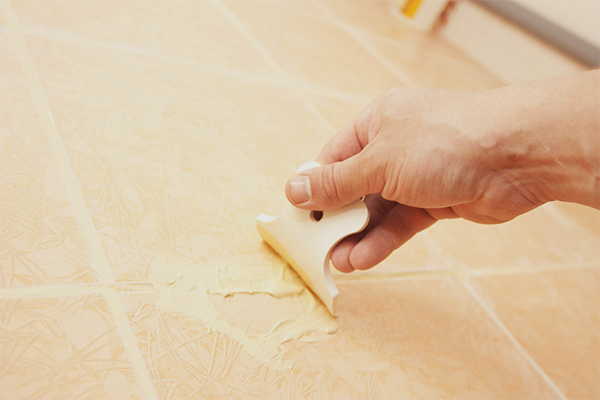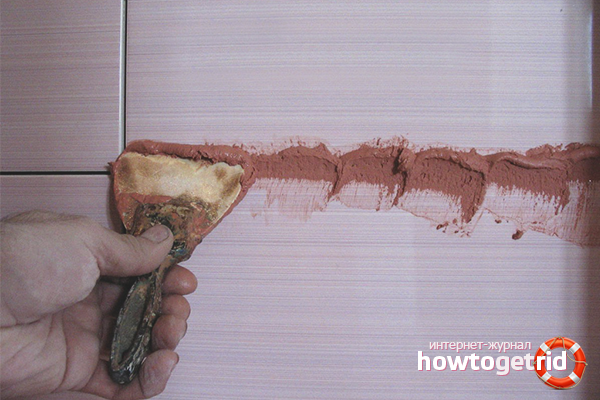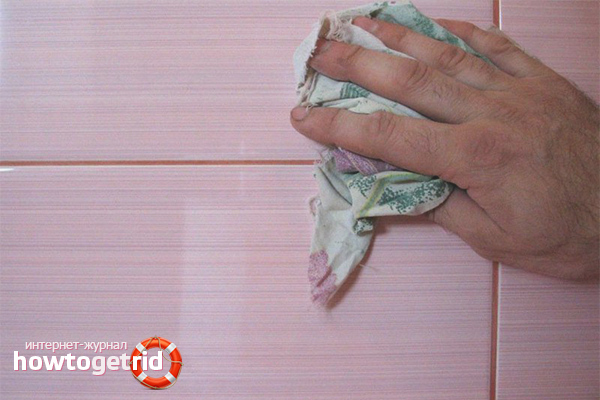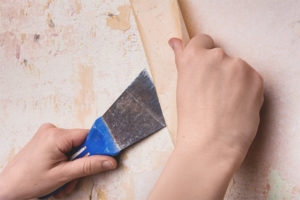The content of the article
The grout is applied to the tile seams to hide small chips and notches left on the edges of the facing material. Silicone and epoxy compounds protect the walls from the accumulation of moisture and fungus, cement varieties improve the adhesion between the individual fragments. Jointing begins with the selection of high-quality material, the preparation of plastic solution and the preparation of sutures for the procedure.
Types of grout
The seams in the living room and bedroom are treated with cement mixtures. They consist of a binder obtained from gypsum and clinker, colored pigments and additives, which are responsible for the rapid hardening of the paste and its plasticity. Cement-based groutings are inexpensive, have a variety of colors, but are not resistant to moisture. The compositions are rarely used for the treatment of seams in the bathroom.In the solution, which will regularly contact with various liquids and steam, instead of water, add a latex plasticizer.
The seams in rooms with a high level of humidity are rubbed with epoxy agents. The composition of the powders include hardeners and pigmented resins. Epoxy grout expensive, but they are resistant to dirt and detergents, do not absorb moisture. Mortars made from pigmented resins are thick and viscous, so only professionals who repeatedly fix the joints between the tiles cope with them.
Corner and deformed seams are treated with silicone sealants. They are not as durable as cement and epoxy solutions, but they have several advantages:
- masking defects facing material;
- resistant to moisture;
- possess antifungal properties.
Silicone sealants have a variety of colors, but over time they may turn yellow. The solutions are elastic, but with regular contact with food they become loose and gradually begin to crumble.
Seams up to 5 mm wide are rubbed with cement or epoxy mixtures.Large joints between the tiles close up the compositions, which contain sand. The additive increases the strength of grouting, but makes the surface of the joints rough. Mortars with sand are just two shades: gray and white.
The composition of high-quality mixtures should include:
- impregnation;
- varnishes;
- cement;
- latex.
Components provide elasticity and durability of the paste. In the grout for the bath and kitchen should be antifungal substances.
Preparation of the solution
Beginners can buy liquid mixes in hardware stores that do not need to be diluted with water. It is enough to open the package and close the joints. But the ready-made compositions are expensive and stored less than dry powders for the preparation of solutions.
Usually, for 1 kg of dry mix, 250–300 ml of water is taken. Some manufacturers have different proportions. Before preparing the solution, you need to carefully study the instructions, which indicate the ratio of the workpiece and the liquid.
The grout is mixed with water in a clean bucket or basin. If old cement or other solutions remain on the container walls, they will react with the grout, its elasticity and tightness will decrease.
In a bucket pour 50–60 ml of water. Add the fourth part of the grout, knead or mass with a spatula. Paste adjusted to uniformity. Gradually pour in water, then pour a new batch of powder. Ready solution insist 10-15 minutes, and then put on the prepared seams.
Liquid grout can not be stored for longer than 12-24 hours. It is covered with film, becomes unsuitable. It is better to mix as much powder and water as you need by 1.5 square meters. m
Seam preparation
The gaps after removal of the fixing crosses are cleaned from the remnants of tile glue and dirt. A dried mortar is scraped from the edges of the facing material with a spatula or a stationery knife. Instead of tools with an iron blade use a wooden stick. It does not leave jags and scratches, but it slows down the process.
Tile adhesive is removed not only from the edges, but also directly from the seams. A spatula with a pointed blade or screwdriver will do. The tool should penetrate to a depth of 5–6 mm. Gaps after treatment with a spatula are cleaned with a stiff brush or paint brush. She removes trash and glue.
The floors and walls after the removal of the frozen solution are vacuumed.This is one of the best ways to clean the joints of building chips, glue and dirt. After the gaps between the tiles wipe with a damp cloth or a soft sponge. When they dry, begin to apply grout.
If the surface of the tile is porous, the edges are covered with masking tape. Use a tape width of 3-5 mm, which is pasted along the seams. It is difficult to clean porous ceramics from grout residues, it is necessary to paint stains with special compositions. It is easier and cheaper to buy a scotch.
Application and tamping
The seams on the wall are rubbed off after 7 days, when the tile glue finally hardens. The gaps between the tiles before work moistened with water. The liquid is applied with a thin brush. Moisture provides grip adhesion to the base.
Seams on the floor in the bathroom or kitchen cover up after a day. Apartment owners can not forget about the existence of these rooms for as much as 7 days. They regularly use the toilet, stove and sink, bring dirt and debris into the room. It gets into the seams and reduces their hygiene and tightness.
The gaps between the tiles before grouting are treated with antifungal compounds.Preparations are applied after cleansing the seams from building glue and dust. Leave for a day to dry. Apply grout with a rubber trowel. Additionally, you will need:
- a bucket of warm clean water without detergent;
- big sponge with a hard surface;
- cable diameter of 0.5 mm less than the size of the seam.
Thick paste for grouting gaps between the plates is poured into a small tray or bowl, which is convenient to hold with one hand. The second squeezes spatula. Using a tool, scoop up some mass and apply on the seam. Rubber grout tamped with a rubber blade, so that voids do not form between the dried mass and the wall. The smaller the portion of the paste, the easier it is to distribute it over the gap between the tiles.
Well rammed grout is elastic and dense. Beginners will realize that there are no more voids left when the spatula cannot penetrate the seam filled with paste. The tool will meet resistance.
The remains of the grout removed with a spatula, which is set perpendicular to the seam. The rubber blade moves slowly down or to the side. Excess paste is returned to the container with the grout. Divorces are not washed away immediately, but after 20-30 minutes.
Seams after processing leave to dry.Paste takes 20 minutes to become plastic. While the grout is not completely hardened, the formation and clearance of the gaps between the tiles are carried out.
In a bucket of warm water, dip a clean sponge or rag and carefully squeeze it out. If a lot of liquid remains in the cloth, it will be absorbed into the grout. Moisture - the cause of bright spots on the seams. They stand out against the background of a paler grout and look ugly.
Sponge dipped in water, carried out on the gap between the tiles. The hard surface will remove the top layer of grout, because it should be 0.2–0.3 mm lower than the edge of the tile. Rags erase the remnants of pasta from the ceramic surface, until they are dry. After each treated seam, the sponge is dipped into a bucket and rinsed. The foam rubber workpiece, on which the grout remains, washes out the dried paste and leads to the deformation of the seam.
Embroider the gaps between the tiles is not necessary. The procedure is intended for the formation of flat and smooth seams without cavities and pits. A cable length of 15–20 cm will be needed. The workpiece is washed or wiped with a damp cloth before work so that there are no dirty stains or stains on the surface of the grout.
The cable is lightly pressed with a finger into the plastic paste and carried to the corner of the tile. The grout that came out of the seam is removed with a damp sponge. If the mass has become hilly, you need to run a cable through it a second time. The pits and cavities left after the jointing, gently close up with fresh grout. Prepare a small portion of thick mastic and put on the problem areas with your fingers. Press in and leave to dry. If the grout is too much, there may be areas that differ in color from the rest.
Final processing
Mastic, got out of the seams, sweep dry rags. Particles of pasta, which had time to dry, removed from the ceramic surface grater. The tool resembles a wide scraper with a rubber nozzle.
Grater moves diagonally. The wide blade is located perpendicular to the seam. Putty pieces that have separated from the wall are removed from the tool by hand. It is impossible for mastic lumps to fall into the gaps between the facing material. They can damage the dried layer of grout, and will have to re-process the seams.
Important: To remove dried pasta from embossed or glossy tiles is very difficult.The remnants of the grout are recommended to remove immediately, until they have managed to harden, and to wipe the edges of the tile with a rag or toothbrush.
Ceramic surface is cleaned of mastic residues with a damp sponge or cloth. Wet removal of grout is carried out after 20-30 minutes after removing the paste with a grater. The glossy shine of the tile will be returned by special solutions, which include:
- lemon juice;
- ammonia;
- table or apple vinegar;
- mustard powder;
- salt;
- Toothpaste;
- detergent.
One component or a cocktail of several ingredients is diluted with water. Sponge moistened in a solution and spend on the wall. If on the tile surface there is a stretching trace of the color of the grout, you need to wait another 10-15 minutes.
Sponge spend on the ceramic surface, removing the remains of mastic. The foam rubber blank is rinsed after each tile so that stains do not remain. When the old solution gets a dirty shade, prepare a portion of the new.
After wet cleaning, carefully inspect the seams and fill the grooves left after the sponge. Wait until the grout dries, then polish the ceramic surface with a dry soft cloth to bring the tile back to its original shine.
Mastic before final drying is covered with a layer of silicone sealant.Protective material must be used for the treatment of seams in the bathroom and kitchen. Translucent paste prevents the appearance of fungus. The sealant is applied with a thin brush, if you need to process only the seams. Foam roller captures and grout, and ceramic tiles.
Clean and dry veneer material is polished. Sprayed onto the surface means for glass and mirrors, and then wipe the tiles with a soft cloth until it starts to shine.
Even a novice can fill the gap between the facing material with mastic. Instructions will tell you how to prepare the grout to the correct consistency. Hands will get used to the spatula in 5-10 minutes, and after half an hour the novice will determine by eye how much paste should be put into the seam. The main thing is not to be afraid of tools and follow the recommendations so that everything will work out.
Video: master class on grouting floor tiles













To send